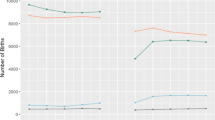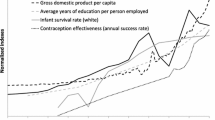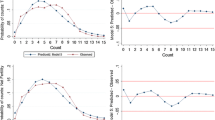Abstract
Understanding how mortality and fertility are linked is essential to the study of population dynamics. We investigate the fertility response to an unanticipated mortality shock that resulted from the 2004 Indian Ocean tsunami, which killed large shares of the residents of some Indonesian communities but caused no deaths in neighboring communities. Using population-representative multilevel longitudinal data, we identify a behavioral fertility response to mortality exposure, both at the level of a couple and in the broader community. We observe a sustained fertility increase at the aggregate level following the tsunami, which was driven by two behavioral responses to mortality exposure. First, mothers who lost one or more children in the disaster were significantly more likely to bear additional children after the tsunami. This response explains about 13 % of the aggregate increase in fertility. Second, women without children before the tsunami initiated family-building earlier in communities where tsunami-related mortality rates were higher, indicating that the fertility of these women is an important route to rebuilding the population in the aftermath of a mortality shock. Such community-level effects have received little attention in demographic scholarship.

Similar content being viewed by others
Notes
As an example of a shift in perceptions occurring in the context of mortality increase, Trinitapoli and Yeatman (2011) observed an association between uncertainty about survival driven by the AIDS epidemic in Malawi and the desired timing of fertility initiation among adolescents.
In these cases, deaths are thought to have arisen as a result of residents having been elsewhere during the tsunami.
For each quarter-year, each woman who is alive and aged 15–49 contributes an observation; the pooled data include 176,862 observations for 6,363 women. The sample includes all age-eligible women who were interviewed in the pre-tsunami baseline survey and therefore represent the pre-tsunami population.
Standard errors are estimated by bootstrapping the sample using 10,000 replications (Efron and Tibshirani 1994).
Although the data are designed to support analysis of fertility timing using, for example, an event-history approach, the main goal of this research is to measure the extent to which there has been successful population rebuilding five years after the tsunami, which is provided by an estimate of γ 1 in Model 1.
The number of communities is smaller than shown in Table 1 because the analysis is conditioned on women of reproductive age surviving the disaster and being in interviewed in follow-up surveys.
References
Agadjanian, V., & Prata, N. (2002). War, peace, and fertility in Angola. Demography, 39, 215–231.
Ashton, B., Hill, K., Piazza, A., & Zeitz, R. (1984). Famine in China, 1958–61. Population and Development Review, 10, 613–645.
Atella, V., & Rosati, F. C. (2000). Uncertainty about children’s survival and fertility: A test using Indian microdata. Journal of Population Economics, 13, 263–278.
Athukorala, P.-C., & Resosudarmo, B. P. (2005). The Indian Ocean tsunami: Economic impact, disaster management, and lessons. Asian Economic Papers, 4, 1–39.
Blanc, A. (2004). The role of conflict in the rapid fertility decline in Eritrea and prospects for the future. Studies in Family Planning, 35, 236–245.
Borneman, J. (2002). Reconciliation after ethnic cleansing: Listening, retribution, affiliation. Public Culture, 14, 281–304.
Burrows, M., Frankenberg, E., Katz, P., Sikoki, B., & Thomas, D. (2012, May). Family formation in Indonesia after the 2004 Indian Ocean tsunami. Paper presented at the Annual Meeting of the Population Association of America, San Francisco, CA.
Cain, M. (1981). Risk and insurance: Perspectives on fertility and agrarian change in India and Bangladesh. Population and Development Review, 9, 688–702.
Caldwell, J. C. (2004). Social upheaval and fertility decline. Journal of Family History, 29, 382–406.
Carta, G., D’Alfonso, A., Colagrande, I., Catana, P., Casacchia, M., & Patacchiola, F. (2012). Post-earthquake birth-rate evaluation using the brief cope. Journal of Maternal-Fetal and Neonatal Medicine, 25, 2411–2414.
Central Bureau of Statistics (CBS) (Indonesia), State Ministry of Population/National Family Planning Coordinating Board (NFPCB), Ministry of Health (MOH), & Macro International Inc. (MI). (2008). Indonesia demographic and health survey 2007. Calverton, MD: CBS and MI.
Cohan, C. L. (2010). Family transitions following natural and terrorist disaster: Hurricane Hugo and the September 11 terrorist attack. In T. W. Miller (Ed.), Handbook of stressful transitions across the lifespan (pp. 149–164). New York, NY: Springer.
Cohan, C. L., & Cole, S. W. (2002). Life course transitions and natural disaster: Marriage, birth, and divorce following Hurricane Hugo. Journal of Family Psychology, 16, 14–25.
Conning, J., & Udry, C. (2007). Rural financial markets in developing countries. In R. Evenson & P. Pingali (Eds.), Handbook of agricultural economics (Vol. 3, pp. 2857–2908). Amsterdam, The Netherlands: North-Holland.
Doocy, S., Gorokhovich, Y., Burnham, G., Balk, D., & Robinson, C. (2007). Tsunami mortality estimates and vulnerability mapping in Aceh, Indonesia. American Journal of Public Health, 97(Suppl. 1), S146–S151.
Efron, B., & Tibshirani, R. J. (1994). An introduction to the bootstrap. Boca Raton, FL: Taylor and Hall.
Eversley, D. E. C. (1957). A survey of population in an area of Worcestershire from 1660–1850 on the basis of parish records. Population Studies, 10, 253–279.
Finlay, J. E. (2009). Fertility response to natural disasters: The case of three high mortality earthquakes (Policy Research Working Paper No. 4338). Washington, DC: World Bank.
Frankenberg, E. (1998). The relationship between infant and child mortality and subsequent fertility in Indonesia. In M. R. Montgomery & B. Cohen (Eds.), From death to birth: Mortality decline and reproductive change (pp. 316–338). Washington, DC: National Academies Press.
Frankenberg, E., Gillespie, T., Preston, S., Sikoki, B., & Thomas, D. (2011). Mortality, the family, and the Indian Ocean tsunami. The Economic Journal, 121, F162–F182.
Fritsche, I., Jonas, E., Fischer, P., Koranyi, N., Berger, N., & Fleischmann, B. (2007). Mortality salience and the desire for offspring. Journal of Experimental Social Psychology, 43, 753–762.
Geertz, C. (1968). Agricultural involution: The processes of ecological change in Indonesia. Berkeley, CA: University of California Press.
Gillespie, T., Chu, J., Frankenberg, E., & Thomas, D. (2007). Assessment and prediction of natural hazards from satellite imagery. Progress in Physical Geography, 31, 459–470.
Gray, C., Frankenberg, E., Gillespie, T., Sumantri, C., & Thomas, D. (2014). Studying displacement after a disaster using large scale survey methods: Sumatra after the 2004 Tsunami. Annals of the Association of American Geographers, 104, 594–612.
Grimard, F. (1997). Household consumption smoothing through ethnic ties: Evidence from Côte d’Ivoire. Journal of Development Economics, 53, 391–422.
Grummer-Strawn, L. M., Stupp, P. W., & Mei, Z. (1998). Effect of a child’s death on birth spacing: A cross-national analysis. In M. R. Montgomery & B. Cohen (Eds.), From death to birth: Mortality decline and reproductive change (pp. 39–73). Washington, DC: National Academies Press.
Guha-Sapir, D., & Below, R. (2006). Collecting data on disaster: Easier said than done (CRED Research Paper No. 221). Brussels, Belgium: Centre for Research on the Epidemiology of Disasters.
Guha-Sapir, D., & Hoyois, P. (2012). Measuring the human and economic impact of disasters. London, UK: Center for Research on the Epidemiology of Disasters, Government Office for Science.
Hamoudi, A., Frankenberg, E., Sumantri, C., & Thomas, D. (2014). Impact of the December 2004 earthquake and tsunami on birth outcomes in Aceh, Indonesia (Working paper). Durham, NC: Department of Economics, Duke University.
Hapsari, E. D., Widyawati, Nisman, W. A., Lusmilasari, L., Siswishanto, R., & Matsuo, H. (2009). Change in contraceptive methods following the Yogyakarta earthquake and its association with the prevalence of unplanned pregnancy. Contraception, 79, 316–322.
Heuveline, P. (1998). “Between one and three million”: Toward demographic reconstruction of a decade of Cambodian history (1970–79). Population Studies, 52, 49–65.
Heuveline, P., & Poch, B. (2007). The Phoenix population: Demographic crisis and rebound in Cambodia. Demography, 44, 405–426.
Hill, K. (2004). War, humanitarian crises, population displacement, and fertility: A review of evidence. Washington, DC: National Resource Council.
Hossain, M. B., Phillips, J. F., & LeGrand, T. K. (2007). The impact of childhood mortality on fertility in six rural thanas of Bangladesh. Demography, 44, 771–784.
Hosseini-Chavoshi, M., & Abbasi-Shavazi, M. J. (2013). Demographic consequences of the 2003 Bam earthquake. Canberra, Australia: International Conference on the Demography of Disasters, Australian National University.
Huber, P. (1967). The behavior of maximum likelihood estimates under nonstandard conditions. Proceedings of the Firth Berkeley Symposium on Mathematical Statistics and Probability, 1, 221–233.
Jansen, S., & Helms, E. (2009). The “white plague”: National-demographic rhetoric and its gendered resonance after the post-Yugoslav wars. In C. Eifler & R. Seifert (Eds.), Gender dynamics and post-conflict reconstruction (pp. 219–244). Frankfurt, Germany: Peter Lang.
Kuate Defo, B. (1998). Fertility response to infant and child mortality in Africa with special reference to Cameroon. In M. R. Montgomery & B. Cohen (Eds.), From death to birth: Mortality decline and reproductive change (pp. 254–315). Washington, DC: National Academies Press.
Lee, R. (1997). Population dynamics: Equilibrium, disequilibrium, and consequences of fluctuations. In M. R. Rosenzweig & O. Stark (Eds.), Handbook of Population Economics (Vol. 1B, Cap 19, pp. 1063–1115). Amsterdam, The Netherlands: North Holland.
LeGrand, T., Koppenhaver, T., Mondain, N., & Randall, S. (2003). Reassessing the insurance effect: A qualitative analysis of fertility behavior in Senegal and Zimbabwe. Population and Development Review, 29, 375–403.
Lindstrom, D. P., & Berhanu, B. (1999). The impact of war, famine, and economic decline of marital fertility in Ethiopia. Demography, 36, 247–261.
Lindstrom, D. P., & Kiros, G.-E. (2007). The impact of infant and child death on subsequent fertility in Ethiopia. Population Research and Policy Review, 26, 31–49.
Marshall, B. K., & Picou, J. S. (2008). Postnormal science, precautionary principle, and worst cases: The challenge of twenty-first century catastrophes. Sociological Inquiry, 78, 230–247.
Martin, J. A., Hamilton, B. E., Sutton, P. D., Ventura, S. J., Menacker, F., & Monson, M. L. (2003). Births: Final data for 2002 (National Vital Statistics Reports 52(10)). Hyattsville, MD: National Center for Health Statistics.
McAdoo, B. G., Richardson, N., & Borrero, J. (2007). Inundation distances and run-up measurements from ASTER, QuickBird and SRTM Data, Aceh Coast, Indonesia. International Journal of Remote Sensing, 28, 2961–2975.
Montgomery, M. R. (2000). Perceiving mortality decline. Population and Development Review, 26, 795–819.
Montgomery, M. R., & Cohen, B. (Eds.). (1998). From death to birth: Mortality decline and reproductive change. Washington, DC: National Academies Press.
Morin, R. (2002, March 31). A 9/11 baby boom? The Washington Post, p. B5.
Nakamura, K., Sheps, S., & Arck, P. C. (2008). Stress and reproductive failure: Past notions, present insights, and future directions. Journal of Assisted Reproduction and Genetics, 25(2–3), 47–62.
Nakonezny, P. A., Reddick, R., & Rodgers, J. L. (2004). Did divorces decline after the Oklahoma City bombing? Journal of Marriage and Family, 66, 90–100.
Neria, Y., Nandi, A., & Galea, S. (2008). Post-traumatic stress disorder following disasters: A systematic review. Psychological Medicine, 38, 467–480.
Norris, F. H., Friedman, M. J., Watson, P. J., Byrne, C. M., Diaz, E., & Kaniasty, K. (2002). 60,000 disaster victims speak: Part I. An empirical review of the empirical literature, 1981–2001. Psychiatry, 65, 207–239.
Olsen, R. J. (1980). Estimating the effect of child mortality on the number of births. Demography, 17, 429–443.
Palloni, A., & Rafalimanana, H. (1999). The effects of infant mortality on fertility revisited: New evidence from Latin America. Demography, 36, 41–58.
Palloni, A., & Tienda, M. (1986). The effects of breastfeeding and pace of fertility on mortality at early ages. Demography, 23, 31–52.
Parker, V. J., & Douglas, A. J. (2010). Stress in early pregnancy: Maternal neuro-endocrine-immune responses and effects. Journal of Reproductive Immunology, 85, 86–92.
Pinghui, Z. (2013, May 7). New births help Sichuan quake victims overcome loss of children. South China Morning Post. Retrieved from http://www.scmp.com/news/china/article/1231719/new-births-help-sichuan-quake-victims-overcome-loss-children
Portner, C. C. (2007). Gone with the wind? Hurricane risk, fertility and education. Unpublished manuscript, Department of Economics, University of Washington, Seattle, WA.
Preston, S. H. (1978). The effects of infant and child mortality on fertility. New York, NY: Academic Press.
Qin, L., Luo, S., Li, X., Wang, Y., & Li, S. (2009). Fertility assistance program following the Sichuan earthquake in China. International Journal of Gynecology & Obstetrics, 104, 182–183.
Ramakrishnan, D., Ghosh, S., Raja, V., Chandran, R., & Jeyram, A. (2005). Trails of the killer tsunami: A preliminary assessment using satellite remote sensing technique. Current Science, 88, 709–711.
Rindfuss, R. R., & Sweet, J. A. (1978). The pervasiveness of postwar fertility trends in the United States. In K. E. Taeuber, L. L. Bumpass, & J. A. Sweet (Eds.), Social demography (pp. 15–42). New York, NY: Academic Press.
Rodgers, J. L., St. John, C. A., & Coleman, R. (2005). Did fertility go up after the Oklahoma City bombing? An analysis of births in metropolitan counties in Oklahoma. Demography, 42, 675–692.
Rosenzweig, M. R., & Schultz, T. P. (1983). Consumer demand and household production: The relationship between fertility and child mortality. American Economic Review, 73, 38–42.
Rosero-Bixby, L. (1998). Child mortality and the fertility transition: Aggregated and multilevel evidence from Costa Rica. In M. R. Montgomery & B. Cohen (Eds.), From death to birth: Mortality decline and reproductive change (pp. 384–410). Washington, DC: National Academy Press.
Sandberg, J. (2006). Infant mortality, social networks, and subsequent fertility. American Sociological Review, 71, 288–309.
Scelfo, J. (2002). A 9-11 baby boomlet. Newsweek, 139(22), 42.
Segraves, R. T. (1998). Psychiatric illness and sexual function. International Journal of Impotence Research, 10, S131–S133.
Stein, Z., & Susser, M. (1975). Fertility, fecundity, famine: Food rations in the Dutch Famine 1944/5 have a causal relation to fertility, and probably to fecundity. Human Biology, 47, 131–154.
Suri, T. (2003). Spillovers in village consumption: Testing the extent of partial insurance. Unpublished manuscript, Department of Economics, Yale University, New Haven, CT.
Townsend, R. M. (1994). Risk and insurance in village India. Econometrica, 62, 539–591.
Trinitapoli, J., & Yeatman, S. (2011). Uncertainty and fertility in a generalized AIDS epidemic. American Sociological Review, 76, 935–954.
Umitsu, M. (2011). The geoenvironment and the giant tsunami disaster in the Northern part of Sumatra Island, Indonesia. In P. P. Karan & S. P. Subbiah (Eds.), The Indian Ocean tsunami: The global response to a natural disaster (pp. 51–64). Lexington, KY: University Press of Kentucky.
Umitsu, M., Tanavud, C., & Patanakanog, B. (2007). Effects of landforms on tsunami flow in the plains of Banda Aceh, Indonesia, and Nam Khem, Thailand. Marine Geology, 242, 141–153.
Vail, K. E., Juhl, J., Arndt, J., Vess, M., Routledge, C., & Rutjens, B. T. (2012). When death is good for life: Considering the positive trajectories of terror management. Personality and Social Psychology Review, 16, 303–329.
Vos, F., Rodriguez, J., Below, R., & Guha-Supir, D. (2010). Annual disaster statistical review 2009: The numbers and trends. Brussels, Belgium: Centre for Research on the Epidemiology of Disasters (CRED).
Watkins, S., & Menken, J. (1985). Famines in historical perspective. Population and Development Review, 11, 647–675.
Acknowledgments
The authors are grateful for comments from Patrick Heuveline, David Lam, Alberto Palloni, and Jim Walker. This work is supported by the National Institute for Child Health and Human Development (R01HD052762, R01HD051970, R03HD071131), the National Institute on Aging (R01AG031266), the National Science Foundation (CMS-0527763), the Hewlett Foundation, the World Bank, and the MacArthur Foundation (05-85158-000).
Author information
Authors and Affiliations
Corresponding author
Rights and permissions
About this article
Cite this article
Nobles, J., Frankenberg, E. & Thomas, D. The Effects of Mortality on Fertility: Population Dynamics After a Natural Disaster. Demography 52, 15–38 (2015). https://doi.org/10.1007/s13524-014-0362-1
Published:
Issue Date:
DOI: https://doi.org/10.1007/s13524-014-0362-1




